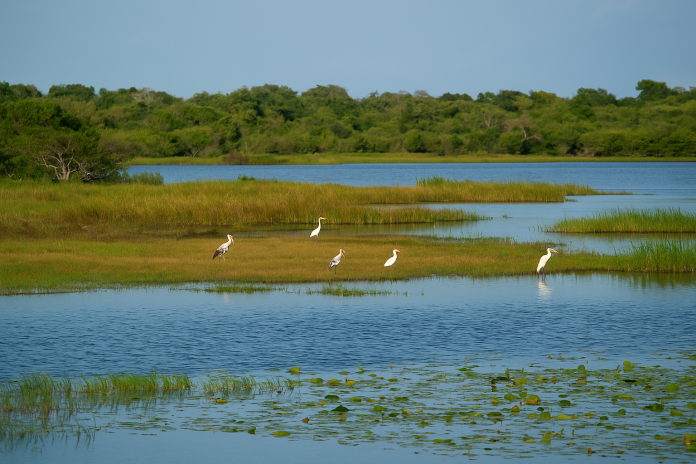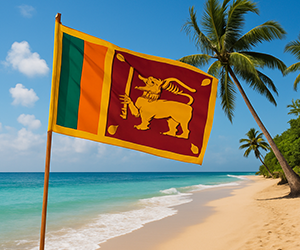Introduction to Kalametiya Bird Sanctuary
Situated on Sri Lanka’s southern coast in the Hambantota District, the Kalametiya Bird Sanctuary is a tranquil haven for birdwatchers, nature lovers, and eco-tourists. Far removed from crowded tourist hubs, this coastal wetland ecosystem offers a rare glimpse into the island’s rich biodiversity. Home to over 150 species of birds and a vast array of other wildlife, Kalametiya is one of the most important and scenic bird sanctuaries in Sri Lanka. With its peaceful lagoons, mangroves, and scenic boat rides, Kalametiya promises a serene and educational experience for visitors of all ages.
History and Ecological Importance
Established in 1938 as a sanctuary to protect Sri Lanka’s coastal avian life, Kalametiya was unfortunately abolished in 1946 due to local opposition. However, it was re-declared as a sanctuary in 1984, covering approximately 2,500 hectares, including lagoons, mangroves, salt marshes, and shrublands. Today, Kalametiya is recognized for its ecological importance, serving as a critical habitat for both resident and migratory bird species. It also supports healthy mangrove ecosystems and functions as a natural flood buffer, making it an essential part of the southern coastal region’s environmental health.
Location and How to Reach
Kalametiya Bird Sanctuary is located in the southern province of Sri Lanka, about 22 kilometers east of Tangalle in the Hambantota District.
- From Colombo: Approximately a 4.5 to 5-hour drive along the Southern Expressway (E01).
- From Galle or Matara: Around 2 to 2.5 hours by car.
- Public Transport: Buses run regularly to Tangalle, from where a tuk-tuk or private taxi can take you to the sanctuary.
- Nearest Towns: Tangalle, Ambalantota, and Hambantota are all within driving distance.
Bird Species Found in Kalametiya
Kalametiya boasts an impressive list of over 150 bird species, both resident and migratory. Some of the most commonly sighted birds include:
- Black-winged Stilt
- Glossy Ibis
- Indian Reef Heron
- Lesser Whistling Duck
- Purple Swamphen
- White-bellied Sea Eagle
- Sri Lanka Junglefowl (national bird)
Migratory birds visit the sanctuary between October and March, making this period especially exciting for birdwatchers. Binoculars and a field guide are highly recommended for those wanting to spot and identify the diverse species.
Other Wildlife in the Sanctuary
Besides its avian population, Kalametiya supports a wide variety of wildlife. You might encounter:
- Monitor lizards and water monitors
- Various amphibians and reptiles
- Mongoose and small jungle mammals
- Crabs, prawns, and fish in the lagoon
The sanctuary’s mangrove forests are also rich with butterflies, dragonflies, and aquatic plants, adding to the area’s rich biodiversity.
Boat Safaris and Eco Tours
One of the most immersive ways to experience Kalametiya is through a guided boat safari. These eco-tours take you through the calm waters of the lagoon, offering close-up views of birds perched on trees, fishing in the shallows, or flying across the sky.
- Sunrise and sunset rides are particularly beautiful and provide the best light for photography.
- Local guides are knowledgeable and can help identify bird species and explain the sanctuary’s ecological significance.
- Tours are typically 1 to 2 hours long.
Best Time to Visit Kalametiya
The best months to visit Kalametiya Bird Sanctuary are from November to April, during the dry season when bird activity is high and trails are accessible.
- October to March is ideal for observing migratory species.
- Avoid visiting during the southwest monsoon (May to September) as rainfall can make boat tours difficult and obscure wildlife sightings.
Visitor Experience and What to Expect
- Opening Hours: Usually from sunrise to sunset.
- Entry Fee: Nominal, usually paid as part of the eco-tour package.
- Duration: Most visits last 1.5 to 3 hours depending on your interest in birdwatching or photography.
- Facilities: Limited, so bring essentials (water, snacks, etc.).
- Accessibility: Easy terrain; suitable for families and elderly visitors.
What to Bring
To ensure a comfortable and rewarding visit, pack the following:
- Binoculars
- Camera with zoom lens
- Sunscreen and insect repellent
- Sunhat or cap
- Reusable water bottle
- Light, breathable clothing
Photography in Kalametiya
Kalametiya is a dream location for bird and nature photographers. Early morning and late afternoon offer the best light. Tips for better photography:
- Keep quiet to avoid startling birds.
- Use a telephoto lens (200mm+ recommended).
- Be patient and observe natural behavior.
- Avoid using flash to protect sensitive wildlife.
Conservation Efforts and Local Community
Kalametiya’s success as a conservation model is largely due to local involvement. Community-based eco-tourism initiatives have provided income opportunities through guiding, boat tours, and handicrafts. Conservation organizations work in tandem with villagers to monitor bird populations, educate school children, and protect the sanctuary from threats like illegal fishing and habitat encroachment.
Your visit helps support these efforts, making Kalametiya an excellent example of sustainable tourism.
Nearby Attractions
- Rekawa Beach: Famous for sea turtle nesting.
- Tangalle Beaches: Ideal for swimming and relaxing.
- Mulkirigala Rock Temple: A cultural site with ancient frescoes and scenic views.
- Ridiyagama Safari Park: Offers wildlife experiences with elephants, lions, and zebras.
Where to Stay
There are several accommodation options near Kalametiya:
- Kalametiya Bird Sanctuary Eco Resort
- Turtle Bay Hotel (mid-range)
- Palm Paradise Cabanas (Tangalle)
- Homestays: Great for immersive cultural experiences
Many of these offer early morning transport to the sanctuary and home-cooked Sri Lankan meals.
Local Cuisine and Dining
You can enjoy authentic Sri Lankan cuisine in small eateries or through your accommodation:
- Rice and curry dishes with fresh seafood
- Pol roti with coconut sambol
- Local fruits like papaya, banana, and mango
Eco-resorts often serve organic meals with ingredients sourced from local farms.
Why Kalametiya is a Must-Visit
Kalametiya Bird Sanctuary is not just a destination; it’s an experience that connects you to nature, conservation, and local culture. Less crowded than places like Yala or Bundala, Kalametiya offers a more intimate and peaceful encounter with wildlife. Its combination of ecological richness, scenic beauty, and responsible tourism makes it a must-visit spot for anyone traveling through southern Sri Lanka.
Conclusion
Kalametiya Bird Sanctuary is a testament to the beauty of Sri Lanka’s southern wetlands. For birdwatchers, photographers, families, and eco-conscious travelers, it offers a unique opportunity to witness wildlife in its natural habitat while supporting local conservation efforts. Plan your visit to Kalametiya and be part of a growing movement that values nature, sustainability, and cultural respect.




